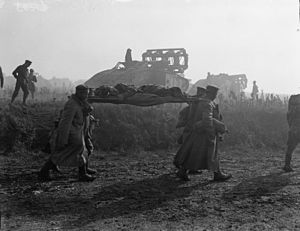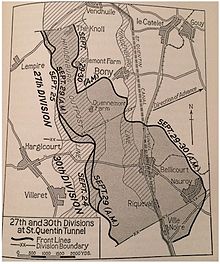Battle of the Saint Quentin Canal

German prisoners carry a wounded man, in the background Mark V tanks with fascines , photo taken on October 2, 1918 near Bellicourt
| date | September 29, 1918 to October 2, 1918 |
|---|---|
| place | Canal de Saint-Quentin |
| output | German defeat |
| consequences | Breakthrough through the Siegfried position |
| Parties to the conflict | |
|---|---|
| Commander | |
|
|
|
| Troop strength | |
| 14 divisions , including 2 divisions of the American Expeditionary Forces | less than 13 divisions |
| losses | |
|
unknown |
unknown |
The Battle of the Saint-Quentin Canal was a pivotal World War I battle that began on September 29, 1918, when British, Australian and US troops broke the Siegfried Line for the first time.
prehistory
After the Battle of Havrincourt on September 12, 1918 and after the Battle of Épehy on September 18, General Georg von der Marwitz had to reckon with the fact that the Allies wanted to break through the Siegfried Line between Le Catelet and Bellicourt : On the one hand, they were in the course of the battle from the north to the south, and on the other hand, it was precisely this section, about 5 km on the Canal de Saint-Quentin , which was completely tunneled under, which was therefore no obstacle for the infantry. That is why the remaining strongest German forces were here. Surprisingly, however, the British 4th Army attacked further south near Riqueval.
The destination was for the 27th US Division (Major General John O'Ryan) west of Bellicourt , the 30th US Division (Major General FH Lewis) west of Bony and for the 46th British Division (Major General William Thwaites) west of Bellenglise . They were supported by the Australian 4th Division (Major General Sinclair-Maclogan), which stood in the back room at Le Verguier . The high command was aware that success against the protected defenses of the Siegfried Line could only be achieved by using tanks. For them the Saint-Quentin Canal was an insurmountable obstacle. The embankments on both sides of the canal were approx. 5 m high. A weapons and ammunition arsenal had been set up in the nearby Riquevaltunnel . Only one bridge spanned the canal there: the Riqueval Bridge . Only if it were possible to capture it intact could the attack with the heavy weapons continue on the other side of the bridge and the Siegfried position could be effectively penetrated.
The capture of the Riqueval Bridge
On September 29, 1918 at 5:50 am, the Australian Corps attacked with the support of two American divisions from the American II Corps (the 27th and 30th US divisions), those of about 150 tanks from the 4th and 5th tanks -Brigade was supported, precisely the interface between the southern 18th Army (General von Hutier ) and the 2nd Army (from September 22nd under General von Carlowitz ) between Cambrai and Saint-Quentin . This approach was supported in the south by the French 1st Army and in the north by the British 46th (North Midland) Division . Despite the latent danger, the bridge has not yet been blown up because it was needed to supply the German troops west of the canal. German pioneers had already attached blast landings to the bridge. The canal and the tunnel were included in the heavily developed Siegfried Line, which, by the standards of the time, was difficult to conquer.
At the time of the attack, there was thick fog (which was probably also caused by smoke grenades by the attackers), which made the situation unmistakable for the defenders. Captain A. H. Charlton took advantage of the moment with the 1 / 6th Battalion of 137th Brigade North Staffords. With a crowd (there should have been nine) of men, he caught the guards by surprise and removed the explosives from the bridge. After signaled success, the 137th Brigade (belonging to the 46th Division) followed at 8:30 a.m. The attackers overran the western positions and crossed the canal during the day. The German troops are said to have shown the lack of morale in the fight by the fact that the majority of the 2000 Germans are said to have preferred capture to escape.
“Between Bellicourt and Bellenglise , the enemy advanced across the canal. In the evening we brought him to a stop in the line north edge of Bellicourt - west edge of Joncourt - Lehaucourt . The regiments north of Gricourt defending themselves from the onslaught had to take their wing back on Lehaucourt in the evening. Troops of all German tribes have an equal share in the largely successful conclusion of yesterday's heavy fighting. The Englishman bought his local successes with very high, bloody losses. "
However, the Supreme Army Command had recognized the hopelessness of the situation, especially since there were no more personnel reserves available. On September 29, 1918, she demanded that the Reich government immediately commence armistice negotiations, stating that the front could collapse any day.
The progress of the battle
The British 46th Division then crossed the canal and secured the passage with machine gun nests on the embankments. During her transition she made 4,600 German prisoners. On October 2, the 46th and 32nd British divisions, supported by the 2nd Australian division, managed to break through the third Beaurevoir line (near the village of Beaurevoir ). It had succeeded in tearing a 17 km break in the Siegfried Line. This was an extraordinarily quick victory in relation to previous experience. Through constant attacks until October 10th, further villages could be taken into possession, making the break in the position system irreversible. The remnants of the 2nd and 18th Armies then withdrew to the so-called Hermann position that had been set up at the beginning of September .
literature
- Jean-Jacques Becker / Gerd Krumeich : The Great War. Germany and France in the First World War 1914–1918 . Klartext Verlag , Essen 2010, ISBN 978-3-8375-0171-1 .
- Susanne Brandt: From the theater of war to the memory room. The Western Front 1914–1940 . Nomos , Baden-Baden 2000, ISBN 3-7890-6758-X .
- Andre Kagelmann / Reinhold Keiner (Ed.): Four from the infantry. Your last days on the Western Front 1918 (by Ernst Johannsen ), MEDIA Net-Edition 2008, ISBN 978-3-939988-03-8 (audio book).
- Dieter Storz: The Western Front 1918 . In military history , issue 3/2008, MGFA, ISSN 0940-4163 .
Web links
- MM PUGIN: L'histoire du Canal de Saint-Quentin In: Mémoires numérisés, Tome XXVII, 1982, pp. 43-60, PDF , French
Footnotes
- ^ The Battles of the Hindenburg Line 1918 . 1914-1918.net. Retrieved July 24, 2011.
- ↑ CEW Bean, Volume VI - The Australian Imperial Force in France during the Allied Offensive, 1918 (1st edition, 1942) , pages 984, 985, 986, 995, 1008, 1013 and 1027 lists the following German divisions facing the attack: 54th , 121st, 185th, 75th Reserve, 21st, 2nd Guards, 2nd, 119th, 241st, 54th, 24th, 8th and 21st Reserve divisions. NOTE: That this list is incomplete, as it doesn't include the forces facing the Allies after the 5th of October.
- ^ Major Raymond E. Priestley, MC, RE: Breaking The Hindenburg Line, The Story of the 46th (North Midland) Division, London 1919
- ^ The German Army Report, Large Headquarters, September 30, 1918 The First Quartermaster General Ludendorff
